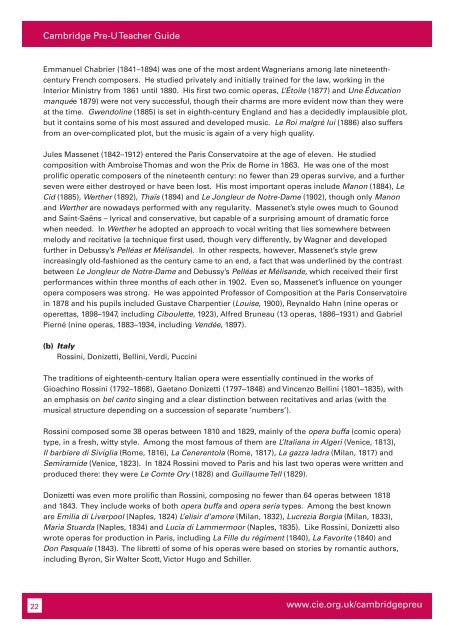Teacher's Guide Cambridge Pre-U MUSIC Available for teaching ...
Teacher's Guide Cambridge Pre-U MUSIC Available for teaching ...
Teacher's Guide Cambridge Pre-U MUSIC Available for teaching ...
You also want an ePaper? Increase the reach of your titles
YUMPU automatically turns print PDFs into web optimized ePapers that Google loves.
22<br />
<strong>Cambridge</strong> <strong>Pre</strong>-U Teacher <strong>Guide</strong><br />
Emmanuel Chabrier (1841–1894) was one of the most ardent Wagnerians among late nineteenthcentury<br />
French composers. He studied privately and initially trained <strong>for</strong> the law, working in the<br />
Interior Ministry from 1861 until 1880. His first two comic operas, L’Étoile (1877) and Une Éducation<br />
manquée 1879) were not very successful, though their charms are more evident now than they were<br />
at the time. Gwendoline (1885) is set in eighth-century England and has a decidedly implausible plot,<br />
but it contains some of his most assured and developed music. Le Roi malgré lui (1886) also suffers<br />
from an over-complicated plot, but the music is again of a very high quality.<br />
Jules Massenet (1842–1912) entered the Paris Conservatoire at the age of eleven. He studied<br />
composition with Ambroise Thomas and won the Prix de Rome in 1863. He was one of the most<br />
prolific operatic composers of the nineteenth century: no fewer than 29 operas survive, and a further<br />
seven were either destroyed or have been lost. His most important operas include Manon (1884), Le<br />
Cid (1885), Werther (1892), Thaïs (1894) and Le Jongleur de Notre-Dame (1902), though only Manon<br />
and Werther are nowadays per<strong>for</strong>med with any regularity. Massenet’s style owes much to Gounod<br />
and Saint-Saëns – lyrical and conservative, but capable of a surprising amount of dramatic <strong>for</strong>ce<br />
when needed. In Werther he adopted an approach to vocal writing that lies somewhere between<br />
melody and recitative (a technique first used, though very differently, by Wagner and developed<br />
further in Debussy’s Pelléas et Mélisande). In other respects, however, Massenet’s style grew<br />
increasingly old-fashioned as the century came to an end, a fact that was underlined by the contrast<br />
between Le Jongleur de Notre-Dame and Debussy’s Pelléas et Mélisande, which received their first<br />
per<strong>for</strong>mances within three months of each other in 1902. Even so, Massenet’s influence on younger<br />
opera composers was strong. He was appointed Professor of Composition at the Paris Conservatoire<br />
in 1878 and his pupils included Gustave Charpentier (Louise, 1900), Reynaldo Hahn (nine operas or<br />
operettas, 1898–1947, including Ciboulette, 1923), Alfred Bruneau (13 operas, 1886–1931) and Gabriel<br />
Pierné (nine operas, 1883–1934, including Vendée, 1897).<br />
(b) Italy<br />
Rossini, Donizetti, Bellini, Verdi, Puccini<br />
The traditions of eighteenth-century Italian opera were essentially continued in the works of<br />
Gioachino Rossini (1792–1868), Gaetano Donizetti (1797–1848) and Vincenzo Bellini (1801–1835), with<br />
an emphasis on bel canto singing and a clear distinction between recitatives and arias (with the<br />
musical structure depending on a succession of separate ‘numbers’).<br />
Rossini composed some 38 operas between 1810 and 1829, mainly of the opera buffa (comic opera)<br />
type, in a fresh, witty style. Among the most famous of them are L’Italiana in Algeri (Venice, 1813),<br />
Il barbiere di Siviglia (Rome, 1816), La Cenerentola (Rome, 1817), La gazza ladra (Milan, 1817) and<br />
Semiramide (Venice, 1823). In 1824 Rossini moved to Paris and his last two operas were written and<br />
produced there: they were Le Comte Ory (1828) and Guillaume Tell (1829).<br />
Donizetti was even more prolific than Rossini, composing no fewer than 64 operas between 1818<br />
and 1843. They include works of both opera buffa and opera seria types. Among the best known<br />
are Emilia di Liverpool (Naples, 1824) L’elisir d’amore (Milan, 1832), Lucrezia Borgia (Milan, 1833),<br />
Maria Stuarda (Naples, 1834) and Lucia di Lammermoor (Naples, 1835). Like Rossini, Donizetti also<br />
wrote operas <strong>for</strong> production in Paris, including La Fille du régiment (1840), La Favorite (1840) and<br />
Don Pasquale (1843). The libretti of some of his operas were based on stories by romantic authors,<br />
including Byron, Sir Walter Scott, Victor Hugo and Schiller.<br />
www.cie.org.uk/cambridgepreu
















